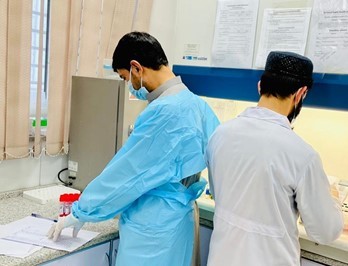Afghanistan’s health system remains stretched in many ways. The country continues to grapple with economic difficulties making it challenging to provide and maintain basic health services, especially given the geographic barriers linked to access and insecurity. Nonetheless, WHO Afghanistan together with partners have been able to invest in surveillance systems, particularly for influenza, which have been strongly leveraged for the COVID-19 pandemic. The established system and network enabled the integrated approach to surveillance which has continued following a political change leading to a freeze in external resources for the country’s health system. Further, the response to the pandemic would not have been efficient if it were not for the well-trained influenza focal points at the sentinel sites. These focal points acted as the shield to the country, collecting specimens of the suspected COVID-19 cases throughout the pandemic, and later trained additional national teams on proper usage of Personal Protective Equipment (PPE) (donning and doffing) and on specimen collection.
Key WHO Contributions
Investment to establish surveillance systems
Procurement of financial and human resources for operationalizations
Provision of capacity building for optimum functioning of laboratories
Procurement of laboratory equipment and supplies for PCR and COVID-19 variant testing
Advocacy towards national authorities for continuation of surveillance activities.
How did Afghanistan, with the support of the WHO Secretariat, achieve this?
The country has experienced considerable conflict and political turmoil in the past several decades. The unstable security and political situation have taken a heavy toll on the country’s public health services. There is a strong association between conflict and the emergence and re-emergence of high threat pathogens owing to the rapid displacement of populations, interrupted access to health care and health commodities, and general re-allocation of country resources [1].
In such situations, influenza surveillance is essential to monitor the potential emergence of novel influenza viruses [1], which could represent a public health emergency of international concern. To prevent this, sensitive influenza surveillance systems need to be in place along with the technical, human, and financial capacities to be able to detect, diagnose, and confirm influenza and other respiratory high-threat pathogens along with initiating and managing a public health response. WHO Afghanistan together with the United States Centers for Disease Control and Prevention (US-CDC) and national authorities have invested heavily in influenza surveillance to be able to detect, confirm the diagnosis and manage influenza viruses. This was made possible by the support from the Pandemic Influenza Preparedness (PIP) Framework Partnerships Contribution (PC) and USCDC fund. This is an international arrangement adopted by the World Health Assembly (WHA) in May 2011 to improve global pandemic influenza preparedness and response.

SARI & ILI sample arrangement for Influenza and Covid-19 diagnosis by RT PCR and NIC.
Photo credit: Momin Khan Murad, Technical Officer, Public Health Labs (WHO Afghanistan). .
As of January 2023, there are nine Severe Acute Respiratory Infection (SARI) and Influenza Like illness (ILI) sentinel sites for influenza surveillance, in nine major hospitals across nine provinces selected based on the geographical locations and population density in Afghanistan. Each site has a trained influenza assistant, through WHO Afghanistan’s support, to collect specimens from both SARI and ILI suspected cases and enter the epidemiological data to the Global Influenza Surveillance and Response System (GISRS) online platform on a regular basis.
At the beginning of the COVID-19 pandemic, these sentinel sites were collecting samples from suspected cases of COVID-19 until the COVID-19 laboratories were established. The first sample of COVID-19 was collected at a PIP-supported influenza sentinel site in Herat province and shipped to the national influenza centre (NIC) for confirmation by polymerase chain reaction (PCR) test. Fully trained and skilled teams had been established with the expertise of WHO Afghanistan and were ready to take samples from infected patients. WHO Afghanistan procured the needed reagents and supplies to perform differential diagnostic tests for influenza and COVID-19 at the laboratories. Afghanistan was among the very few countries in the Eastern Mediterranean Region using the integrated approach of influenza surveillance promoted by the GISRS.
Furthermore, the NIC participates annually in the WHO External Quality Assessment Programme (EQAP) for the detection of influenza viruses by Reverse Transcriptase-PCR. The most recent result obtained was a full score in panel 20. The management of the Central Public Health Laboratory (CPHL)/NIC appreciated PIP support in building the capacity and equipping the NIC.
“I am proud that we attained full score in panel 20, thank you WHO for the support”
Dr Abdul Stanikzai, Head of CPHL/NIC
Afghanistan’s health care system was on the verge of collapse following regime change in August 2021 and the freeze of international funding. Some health facilities were shut down and some programmes were suspended. Many health workers either quit or left the country, leaving fewer workers trying to urgently respond to emergencies. At the same time, COVID-19 continued to spread across the country, with limited resources available to address it. Despite all these challenges, the country’s influenza surveillance system continued to function. The NIC and WHO’s influenza team in Afghanistan successfully advocated the Ministry of Public Health for influenza surveillance activities to resume and today they continue to build on successes achieved previously. This success in advocacy was the result of years of partnership building and investment by WHO Afghanistan and other partners. It is thanks to this investment that an influenza surveillance system was already up and running when COVID-19 hit Afghanistan in February 2020 and which could be leveraged to support the country’s pandemic response, throughout which it has been testing and reporting for both influenza and SARS-CoV2 within its sentinel network. The system will continue to be supported by WHO Afghanistan to maintain its capacity under challenging circumstances.
References

